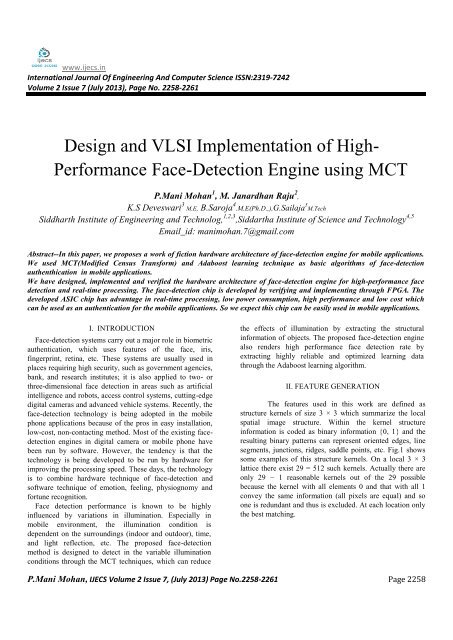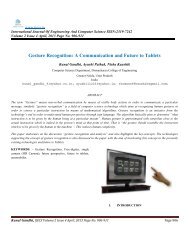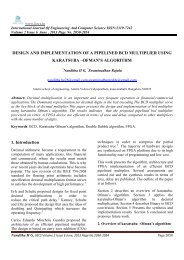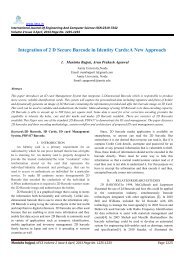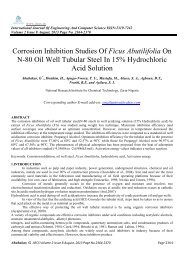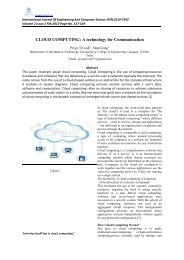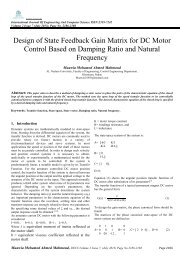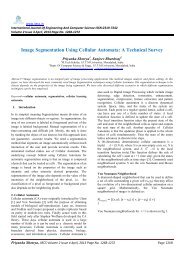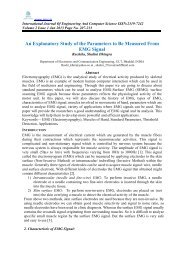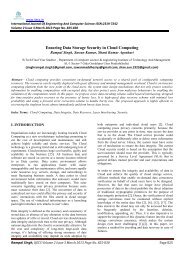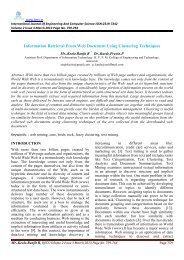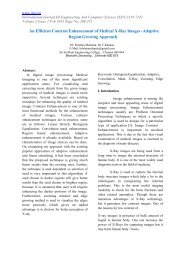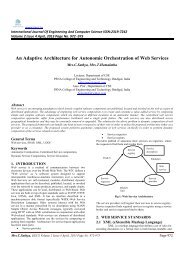Design and VLSI Implementation of High- Performance Face ... - Ijecs
Design and VLSI Implementation of High- Performance Face ... - Ijecs
Design and VLSI Implementation of High- Performance Face ... - Ijecs
Create successful ePaper yourself
Turn your PDF publications into a flip-book with our unique Google optimized e-Paper software.
number <strong>of</strong> good “features” which nevertheless havesignificant variety. One practical method for completing thisanalogy is to restrict the weak learner to the set <strong>of</strong>classification functions each <strong>of</strong> which depend on a singlefeature. In support <strong>of</strong> this goal, the weak learning algorithmis designed to select the single rectangle feature which bestseparates the positive <strong>and</strong> negative examples (thisis similar to the approach <strong>of</strong> Tieu <strong>and</strong> Viola (2000) inthe domain <strong>of</strong> image database retrieval). For each feature,the weak learner determines the optimal thresholdclassification function, such that the minimum number <strong>of</strong>examples are misclassified. A weak classifier (h(x, f, p, θ))thus consists <strong>of</strong> a feature ( f ), a threshold (θ) <strong>and</strong> a polarity(p) indicating the direction <strong>of</strong> the inequality:Here x is a 24 × 24 pixel sub-window <strong>of</strong> an image.In practice no single feature can perform the classificationtask with low error. Features which are selected early in theprocess yield error rates between 0.1 <strong>and</strong> 0.3. Featuresselected in later rounds, as the task becomes more difficult,yield error rates between 0.4 <strong>and</strong> 0.5. Table 1 shows thelearning algorithm.This paper consists <strong>of</strong> a face detector with a single-layerstructure, using only the fourth phase <strong>of</strong> the cascadestructure proposed by Froba <strong>and</strong> Ernst.IV. PROPOSED HARDWARE STRUCTUREsize in face-detection area to embedded system through hostinterfaceFig 1. Block diagram <strong>of</strong> proposed face-detection engineV. EXPERIMENTAL RESULTThe developed face detection system has verifiedsuperb performance <strong>of</strong> 99.76 % detection-rate in variousillumination environments using Yale face database [4] <strong>and</strong>BioID face database [5] as shown in Table 1, Table 2, <strong>and</strong>Figure 2. And also we had verified superb performance inreal-time hardware though FPGA <strong>and</strong> ASIC as shown infigure 3. First, the system was implemented using Virtex5LX330 Board [6] with QVGA(320x240) class camera, LCDdisplay. The developed face-detection FPGA system can beprocessed at a maximum speed <strong>of</strong> 149 frames per second inreal-time <strong>and</strong> detects at a maximum <strong>of</strong> 32 facessimultaneously. Additionally, we developed ASIC Chip [7]<strong>of</strong> 1.2 cm x 1.2 cm BGA type through 0.18um, 1-Poly / 6-Metal CMOS Logic process. Consequently, we verifieddeveloped face-detection engine at real-time by 30 framesper second within 13.5 MHz clock frequency with 226 mWpower consumption(a)Result in various illumination conditions(b) Results from Yale <strong>and</strong> BioID <strong>Face</strong>DB Fig 2. <strong>Face</strong> detection Results(a) FPGA development environment (b) Developed chip <strong>and</strong> systemFig 3. FPGA verification environment <strong>and</strong> ASIC chip systemVI. CONCLUSIONRegarding proposed hardware structure as shownin Figure 1, it is composed <strong>of</strong> color conversion module toconvert to gray image from color image, noise reductionmodule to reduce image noise, image scaler module todetect various size <strong>of</strong> the face, MCT transform module totransform image for robustness various illumination, CD(C<strong>and</strong>idate detector) / CM (Confidence mapper) to detectc<strong>and</strong>idate for final face-detection, position resizer module toresize face c<strong>and</strong>idate areas detected on the scaled-downimages as their corresponding points <strong>of</strong> original image size,data grouper module to group the duplicate areas determinedto be the same face prior to determining the final facedetection areas, overlay processor to play in displaying anoutput by marking square in relation to the final facedetectionarea on the color-based original image from thecamera or to output to transfer the information <strong>of</strong> area <strong>and</strong>This paper has verified a process that overcomes lowdetection rates caused by variations in illuminations thanksto the MCT techniques. The proposed face-detectionhardware structure that can detect faces with high reliabilityin real-time was developed with optimized learning datathrough the Adaboost algorithm. Consequently, thedeveloped face-detection engine has strength in variousillumination conditions <strong>and</strong> has ability to detect 32 varioussizes <strong>of</strong> faces simultaneously.The developed FPGA module can detect faces with highreliability in real-time. This technology can be applied tohuman face-detection logic for cutting-edge digital camerasor recently developed smart phones. Finally, face-detectionchip was developed after verifying <strong>and</strong> implementingthrough FPGA <strong>and</strong> it has advantage in real-time, low powerconsumption <strong>and</strong> low cost. So we expect this chip can beP.Mani Mohan, IJECS Volume 2 Issue 7, (July 2013) Page No.2258-2261 Page 2260
easily used in mobile applications.REFERENCE[1] Paul Viola <strong>and</strong> Michael J. Jones, “Robust real-time face detection”In International Journal <strong>of</strong> Computer Vision, pp. 137-154, 2004.[2] Yoav Freund <strong>and</strong> Robert E. Schapire. "A decision-theoretic generalization<strong>of</strong> on-line learning <strong>and</strong> an application to boosting" in Journal<strong>of</strong> Computer <strong>and</strong> System Sciences, pp. 119-139, 1997.[3] Bernhard Froba <strong>and</strong> Andreas Ernst, "<strong>Face</strong> detection with theModified Census Transform", IEEE International Conference. OnAutomatic <strong>Face</strong> <strong>and</strong> Gesture Recognition, pp. 91-96, Seoul, Korea,May. 2004.[4] Georghiades, A. : Yale <strong>Face</strong> Database, Center for computationalVision <strong>and</strong> Control at Yale University, http: //cvc.yale.edu /projects/yalefaces /yalefa[5] The BioID face database: [http : //www.bioid.com /downloads /facedb/facedatabase.html][6] Dongil Han, Hyunjong Cho, Jongho Choi, Jaeil Cho, "<strong>Design</strong> <strong>and</strong><strong>Implementation</strong> <strong>of</strong> real-time high performance face detection engine",SP(Signal Processing), 47th Book, 3 Issue, The Institute <strong>of</strong>Electronics Engineers <strong>of</strong> Korea Publication(IEEK), March, 2010.[7] Seung-Min Choi, Jiho Chang, Jaeil Cho, Dae-Hwan Hwang,"<strong>Implementation</strong> <strong>of</strong> Robust Real-time <strong>Face</strong> Detection ASIC", IEEKConference 33th Book, 1 Issue, 467-470, Jeju, Korea, June, 2010P.Mani Mohan, IJECS Volume 2 Issue 7, (July 2013) Page No.2258-2261 Page 2261


